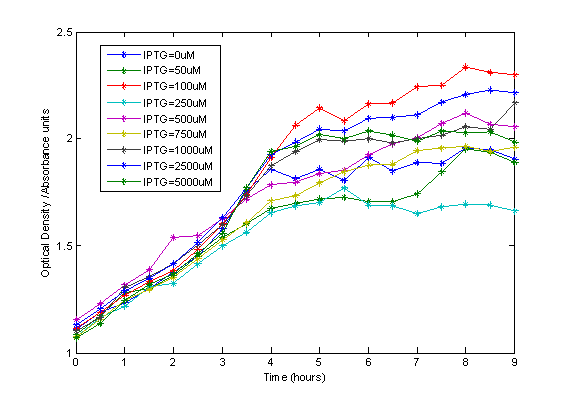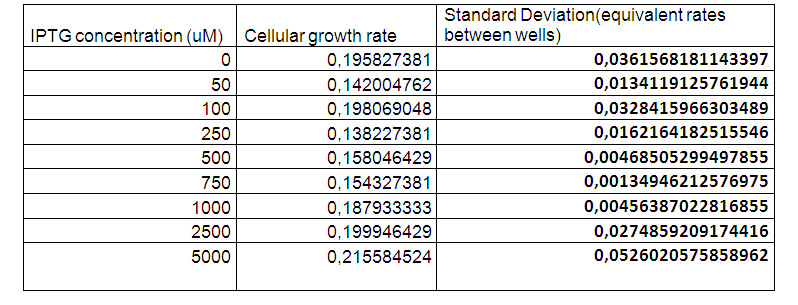Team:Imperial College London/Wetlab/Results/Cheminduction/IPTG
From 2009.igem.org

Experiment:
Different concentrations of IPTG were added to a 96-well plate [link to assay] of e-coli Top 10 cells containing LacI-RFP genetic constructs. Here we measured the optical density of the cells over-time, for different concentrations of IPTG to monitor the effects in the culture. The IPTG growth curve results are plotted below:

Figure 1: Effects of [IPTG] on cell growth
We can see that initially, there is an exponential growth phase followed by saturation of growth once glucose has been used up. In this diagram, effects of IPTG on growth rate are not apparent. Instead, a more informative measure is the growth rate during the exponential growth phase. As we know, if the OD curves follow exponential expression in the form of:
y=yoexp^rt
where r is the growth rate, t is the time in hours, y is the absorbance/OD over time and yo is the initial absorbance/OD, we can simplify the relationship such that:
logy=log(y_o+ rt)
So when we plot log y against t, there is a linear relationship in the exponential growth phase, so we can estimate the growth rate r from there. This is better illustrated in the plots below, showing OD against time for different concentrations of IPTG:

Figure 2: log data with fitted line: Only considered points in the initial exponential phase
Visual assessment of these plots shows that between time=0.5-5 hours, there is a linear phase, so we fit a straight line (red) to estimate the growth rate. After 5 hours, growth saturates and the exponential relationship no longer applies, so the points were discarded.
The estimates of the growth rates shown in the table below show if IPTG concentrations affect cellular growth rate in the exponential phase:

Average rate = 0.1767
Standard deviation = 0.0286
Standard error of the mean = 0.0101
Discussion and conclusion :
We can see that growth rate stays within a narrow range and does not change significantly with concentrations of [IPTG]. Therefore, we can conclude that [IPTG] in the concentration ranges we are using does not affect cellular growth and is non toxic.
 "
"



